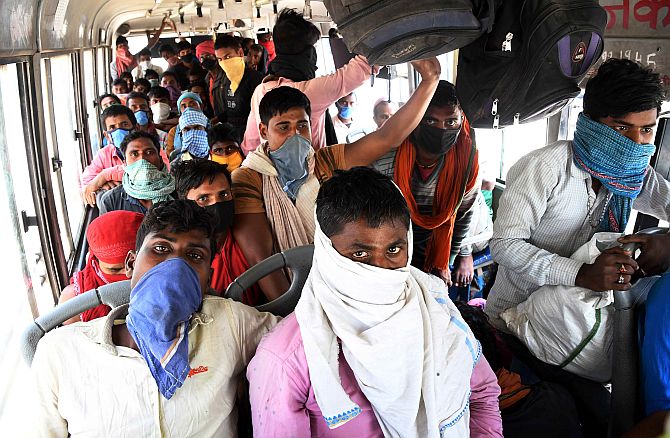There were 86 million salaried jobs in India during 2019-2020.
In August 2020, their count was down to 65 million.
The deficit of 21 million jobs is the biggest among all types of employment, points out Mahesh Vyas.

Salaried employees continued to take a hit in India's job markets during the lockdown.
Five months into the lockdown, they remain the biggest casualty.
Other types of employment have recovered most of their initial losses and some have even gained in employment, but salaried employees continue to suffer increasing job losses.
Salaried jobs do not seem to grow in tandem with economic growth, or even with an increase in entrepreneurship. But, they are suffering the most during the current economic meltdown.
A job is generally understood to be salaried if a person is employed by an organisation to work on a regular basis and is paid a salary at a regular frequency.
In India this frequency is usually a month.
The employing organisation could be the government, which is the most preferred job among Indians, or a private sector enterprise of any size, the larger the better, or a non-government organisation. These are largely formal salaried jobs.
Salaried jobs extend beyond those provided by such organisations and that our minds automatically conjure. They include people employed by households on a salaried basis.
So, maids, cooks, chauffeurs, gardeners, guards are also salaried employees if the terms of their engagement entails a fixed salary at a fixed frequency. These are mostly informal salaried jobs.
All salaried jobs put together account for 21 to 22 per cent of total employment in India. There are many more farmers than salaried jobs. And, there are even more daily wage labourers.
Farmers and daily wage earners together account for nearly two-thirds of the Indian working population.
This structure of the working population does not behove a country that has often boasted of being the fastest growing major economy.
In spite of India's fast growth, the proportion of salaried jobs crawled up at a very slow pace from 21.2 per cent in 2016-2017 to 21.6 per cent in 2017-2018 and to 21.9 per cent in 2018-2019.
During this period, real GVA grew at 6 to 8 per cent per annum. Then, in 2019-2020 when the economy grew by 4 per cent, the share of salaried jobs fell to 21.3 per cent.
The stagnation in salaried jobs, in spite of India's reasonable economic growth in recent years, is not the only incongruence.
It is equally odd that India has been seeing a rapid increase in entrepreneurship without any corresponding increase in salaried jobs.
In 2016-2017, employment in entrepreneurship accounted for 13 per cent of total employment.
This proportion rose to 15 per cent in 2017-2018, then 17 per cent in 2018-2019 and 19 per cent in 2019-2020.
This sustained increase in entrepreneurship in India has not led to a rise in salaried jobs.
The count of entrepreneurs has risen from 54 million in 2016-2017 to 78 million in 2019-2020.
During the same period the count of salaried employees has remained stable at 86 million. It is counterintuitive to see a rise in entrepreneurship, but not a corresponding increase in salaried jobs.
Part of the reason for this is that most of these entrepreneurs are self-employed who do not employ others. Implicitly, they are mostly very small entrepreneurs.
The government has propounded the idea that people should be job providers rather than job seekers. This objective seems to be succeeding, but not entirely in ways that was intended.
Entrepreneurship is often a desperate escape from unemployment rather than an initiative to create jobs. An increase in entrepreneurship of the kind India has been witnessing since 2016-2017 is evidently not the kind that creates salaried jobs.
Farming has been the last resort of job losers during the lockdown.
By August 2020, employment in farming increased by 14 million on a base of 111 million during 2019-2020.
Employment as entrepreneurs had declined early in the lockdown. By August, it increased by nearly 7 million on a base of 78 million.
The losers are salaried employees and daily wage labourers. The latter was the biggest loser in April. It accounted for 91 million of the 121 million jobs lost during the month.
By August, it recovered much of this lost ground. It now has a deficit of a little less than 11 million jobs on a base of 128 million jobs in 2019-2020.
People with salaried jobs were the biggest losers by August 2020.
In April 2020, when total employment fell by 121 million, salaried jobs suffered the least.
While its share in total employment was over 21 per cent in 2019-2020, its share in the fall in April was less than 15 per cent.
But in August, losses in salaried jobs more than wiped out the gains in farming and entrepreneurship.
An estimated 21 million salaried employees have lost their jobs by the end of August. There were 86 million salaried jobs in India during 2019-2020. In August 2020, their count was down to 65 million.
The deficit of 21 million jobs is the biggest among all types of employment.
About 4.8 million salaried jobs were lost in July and then in August, another 3.3 million jobs were gone.
These job losses cannot be confined to only of the support staff among salaried employees.
The damage is likely to be deeper, among industrial workers and also white-collar workers.
Mahesh Vyas is MD and CEO, CMIE P Ltd.










